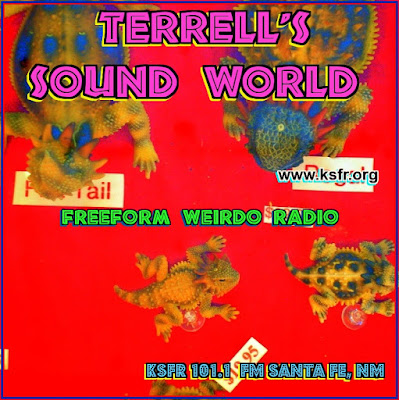January 21, 2005
No matter how harshly critics dismiss tribute albums, the dang things keep proliferating. Someone out there must like ’em. And despite my own grumbling from time to time, in more than a few cases, I like ‘em too.
So here’s my idea: A tribute to tribute albums. Here a batch of “various artists” would do their interpretations of other various artists’ interpretations on a variety of tribute albums.
For example, Alejandro Escovedo could do his version of Elvis Costello’s version of “Ship of Fools” from Deadicated, the Grateful Dead tribute, while Tom Waits could do his take on Los Lobos’ version of “Midnight Shift” on Not Fade Away: Remembering Buddy Holly. Guided by Voices and Beck would have to fight over who covered the Bongwater rendition of “You Don’t Love Me Yet” from the Roky Erikson tribute Where the Pyramid Meets the Eye. The possibilities nearly are infinite …
Meanwhile here’s a bunch of recent tribute albums I’ve been enjoying.
The Late Great Daniel Johnston: Discovered Covered. This is a double-disc set featuring a various-artist tribute on the first disc and the original versions by Johnston on the second. This format actually is a great idea, particularly for an artist as obscure as Johnston. Some of the tunes on Disc Two, namely the ones that originally were released on self-recorded, lo-to-no-fi cassette tapes, are pretty hard to find.
For the uninitiated, Johnston, a Texas resident, is a cult hero of the indie rock world. He's got a history of mental problems, many of which are addressed on his painfully sincere songs of unrequited love, loneliness and rejection.
Many of the interpretations on Disk One emphasize the pretty melodies, which sometimes are obscured by tape hiss on Johnston's early works. This especially is true on "Go," a collaboration between Sparklehorse and The Flaming Lips, Mercury Rev's down-home take on "Blue Clouds" and "Dream Scream" by Death Cab For Cutie, which is more dreamy than screamy.
There are a couple of stripped-down primitive Johnston interpretations, like frog-voiced Calvin Johnson's "Sorry Entertainer," (just vocals and percussion) and "King Kong," which, as done by Tom Waits is a disturbing chant that sounds like an outtake from Waits' recent Real Gone.
But the true standout here is Vic Chesnutt's mournful "Like a Monkey in the Zoo." It already arguable was Johnston's saddest song, but Chesnutt makes it even sadder.
*Hard-Headed Woman" A Celebration of Wanda Jackson. The word "celebration" is right on the mark here. Just about every track on this record sounds like the various artists took to heart the command in Jackson's signature: "Let's Have a Party."
Jackson, for those deficient in rock history credits, was an important rockabilly pioneer. Starting out as a protégé of country star Hank Thompson, she was one 1950s country singer who had no trouble adapting to rock 'n' roll. She's well into her 60s now, but she's still touring.
Not surprisingly, this album is dominated by female singers. Rosie Flores, who helped revive Jackson's career last decade, sings a swingy "In the Middle of a Heartache," that has a lot of Patsy Cline in it. Meanwhile, the indomitable Neko Case rips it up on "Brown-Eyed Handsome Man," Candye Kane is as brassy on "Rock Your Baby" as Laura Cantrell is wide-eyed innocent on "Wasted."
Meanwhile, Jackson's country side is well-represented by Kelly Hogan's smoky "Right or Wrong," Ana Fermin's heartbreaking "The Box it Came In" and Jesse Sykes' sweet moan on "Weary Blues From Waiting."
But Jackson's music isn't just for women. Cornell Hurd's droll vocals on "This Gun Don't Care Who It Shoots," Robbie Fulks' earnest version of "Tears at the Grand Ol' Opry" and Wayne Hancock's rendition of the classic "Let's Have a Party" all are highlights.
But my favorite here is the most radical reworking of a Jackson song, Trailer Bride's surreal take on Jackson's first rockabilly hit "Fujiama Mama." There's heavy drums and monster-movie organ as Melissa Swingle tosses off the lyrics in a carefree way. When she sings "I'm a Fujiama Mama just about to blow my top," it sounds like you'd better get out of her way. It's contributions like this, which take familiar songs to new territory, that make tribute albums worth it.
*Touch My Heart: A Tribute to Johnny Paycheck. Robbie Fulks produced this tribute to the legendary hell-raiser Paycheck, so you know it's going to be tasteful. Fulks rounded up an impressive gaggle of various artists including stars of traditional country (George Jones, Gail Davies, Johnny Bush), alternative country (Neko Case, Mike Ireland, Jim Lauderdale) and beyond.
Mavis Staples does a take on the title song that completely blurs the lines between soul and country. Former NRBQ guitarist and part-time (Santa Fe resident) Big Al Anderson does much the same on "Someone to Give My Love To."
As usual, Hank Williams III sounds like the ghost of his granddaddy on "I'm the Only Hell My Daddy Ever Raised."
And baritone belter Dave Alvin is even more impressive than usual with his tough, bluesy "11 Months and 29 Days."
The saddest part of this record though is the fact that Buck Owens' voice, which has been ravaged by throat cancer, is unrecognizable on "Take This Job and Shove It," where he shares vocals with a rather strange line-up: Wilco's Jeff Tweedy, Bobby Bare and Radney Foster. It's a fun tune, it's just disturbing to hear Buck that way.




